

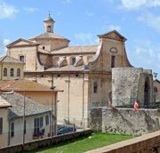
This church and nunnery are renowned for their most famous resident, St Clare of Montefalco, who was buried in the apse of the church. (The other nunneries of Montefalco have a separate page in this website).
St Clare of Montefalco
St Clare’s much older sister, Joanna formed an eremitical community of women at what is now Sant’ Illuminata in ca. 1270 and St Clare joined her in 1274, when she was only six years old. In 1281, Joanna, Clare and some of their sisters moved to a new convent on this site, next to the ancient church of Santa Caterina de Bottaccio. The new community had to overcome the opposition of Franciscan friars and the local people, who objected that the town could not support another mendicant community. However, it managed to survive and, in 1290, secured the protection of Bishop Gerardo Pigolotti of Spoleto, who placed the nuns under the Rule of St Augustine.
When Joanna died 1291, Clare succeeded her as the abbess of the community. She manifested profound devotion to the passion of Christ, and was a renowned mystic: for example, she had a vision in which Christ implanted a cross in her heart, and the associated pain had remained with her until her death.
In 1303, St Clare was finally able to build a church for the sisters and their small congregation. She had prophesied the promotion of Bishop Nicolò Albert da Prato of Spoleto to the rank of cardinal: when he was so-consecrated in December 1303, he sent a diploma that authorised the laying of the foundation stone of the new Oratorio di SS Croce e Caterina.
15th Century
A larger church was subsequently built on the site, and the relics of St Clare were placed there in 1430. The painted wooden chest (ca. 1430) that contained the relics of St Clare at this time is now in the cloister (see below).
In 1478, the Franciscan Pope Sixtus IV made the Observant Franciscan friars of San Fortunato responsible for the spiritual guidance of the nuns of Santa Croce. The nunnery at Sant’ Illuminata (above) closed in 1480, and the nuns there moved to Santa Croce. In 1492, fourteen nuns moved from Santa Chiara to San Leonardo, and adopted the Franciscan (as opposed to their original and more relaxed Augustinian) rule. The three nuns remaining at Santa Croce changed its name to Santa Chiara.
Present Church
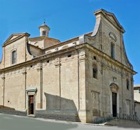
-
✴the vaults of the nave and aisle vaults were completed in 1641-3, at which point the earlier church still stood on the site of the present transept; and
-
✴the cupola and the upper part of the two façades (one of which is on the left wall) were completed between 1663-70.
Exterior
The cloister (1487-92), which was built by Andrea di Ser Vitale and Rosso Lombardo, can apparently be visited on request [although I have yet to manage to do so]. Works of art here include:
-
✴architectural fragments that might have come from the Oratorio di SS Croce e Caterina;
-
✴the painted wooden chest (ca. 1430) that contained the relics of St Clare in the 15th century church; and
-
✴a fresco (16th century) of St Clare between SS Augustine and Nicholas of Tolentino.
Interior
The church has a nave and two aisles.
Cappella di Santa Chiara
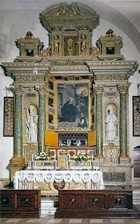
-
✴The altarpiece (1600), which is signed by Francesco Longhi and dated by inscription, depicts St Clare and a kneeling donor, presumably Fabio Tempestivi.
-
✴The statues to the sides represent SS Jerome and Augustine.
-
✴The main relics of St Clare are preserved in the silver urn under the altar, which was delivered by the Jesuits in 1612 on behalf of an anonymous donor.
-
✴Other relics of St Clare are preserved behind two grated niches to the sides, which were opened in 1718 to reveal:
-
•a pectoral cross that Cardinal Giacomo Colonna had given to St Clare;
-
•a silver bust containing her heart;
-
•a silver cross-reliquary with the symbols of the Passion that was discovered in her heart; and
-
•the three stones found in her gall bladder.
Cappella di Sant’ Onofrio
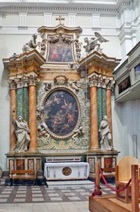
-
✴The Baroque stucco altar (1692) is signed by Camillo Rusconi of Milan and dated by inscription.
-
✴The two panels (ca. 1692) in the chapel, which are attributed to Francesco Refini of Spoleto, depict:
-
•the death of St Onuphrius (in the oval altarpiece); and
-
•the Trinity (above).
High Altar
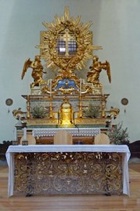
-
✴The gilded wooden sculpture representing the Triumph of the Cross is attributed to Tommaso Granpini of Foligno.
-
✴The ciborium is signed by the gilder Gerolamo Pagliarini of Foligno.
Cappella di Santa Croce
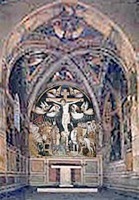
This chapel behind and to the left of the apse, which was formed from the apse of the original oratory here, can be visited on request. It contains an important cycle of frescoes that are the autograph works of two distinct, unknown masters (see the page on the Maestri di Santa Chiara di Montefalco). The inscription under the fresco of the Crucifixion on the altar wall records that] Jean d’ Amiel, the Rector of the Duchy of Spoleto, commissioned them in 1333.
The frescoes given to the respective masters are:
Primo Maestro di Santa Chiara di Montefalco
The frescoes given to this master are:
-
✴the Crucifixion, a crowded fresco on the altar wall of the chapel;
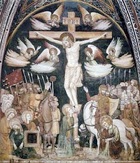
-
✴the frescoes of the symbols of the Evangelists in the vaults; and
-
✴the frescoes on the right wall, which include:
-
•scenes from the lives of SS Clare of Montefalco and Blaise (Biagio), including this one St Clare’s vision of the Virgin and the baby Jesus; and
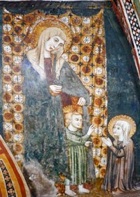
-
•the frescoes in the tabernacle, which depict:
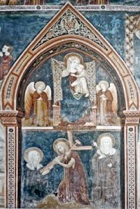
-
-the Madonna and Child with the Archangels Raphael and Gabriel; and
-
-St Clare’s vision of the Risen Christ implanting a cross in her heart, with the Blessed Joanna.
Secondo Maestro di Santa Chiara di Montefalco
The frescoes given to this master are those on the left wall, depict:
-
✴death of St Clare of Montefalco, in which St Clare sits up in bed, surrounded by solicitous monks and nuns (illustrated here);
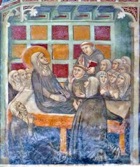
-
✴the martyrdom of St Catherine of Alexandria, to the right of it; and
-
✴Christ in glory with SS Blaise and Catherine of Alexandria (illustrated below, to the right).

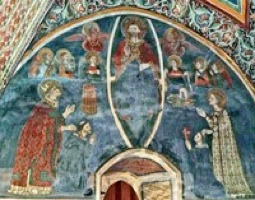
Jean d’ Amiel appears three time in these frescoes:
-
✴he kneels with St Mary Magdalene at the foot of the cross in the Crucifixion; and
-
✴SS Blaise and Catherine of Alexandria present him to Christ in glory on the left wall.
St Clare of Montefalco (14th century)
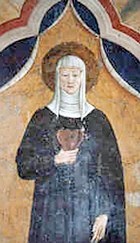
Art from Santa Croce
Dossal (14th century)
This long low dossal, which is attributed to the Primo Maestro di Santa Chiara di Montefalco, was documented in 1925, when it was expropriated from Santa Chiara and sent to the Vatican. It depicts the Crucifixion six scenes from each of the lives of SS Blaise and Catherine of Alexandria. It seems likely that Jean d’ Amiel commissioned it in 1333 for what was then Santa Croce. It is now in the Vatican Palace.

